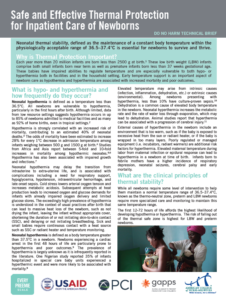
A Do No Harm Technical Brief
Neonatal thermal stability, defined as the maintenance of a constant body temperature within the physiologically acceptable range of 36.5–37.4°C is essential for newborns to survive and thrive. Each year more than 20 million infants are born less than 2500 g at birth. These low birth weight (LBW) infants comprise both small infants born near term as well as premature infants born less than 37 weeks gestational age. These babies have impaired abilities to regulate temperature and are especially vulnerable to both hypo- or hyperthermia both in facilities and in the household setting. Early temperature support is an important aspect of newborn care as hypothermia and hyperthermia are associated with increased mortality and poor outcomes. This brief highlights current recommendations and evidence-based best practices to ensure safe and effective thermal protection for inpatient newborn care.
The Every Preemie—SCALE project is pleased to share the Do No Harm Technical Brief Series. This series highlights the safe and effective use of specific inpatient newborn care interventions, with the guiding principle of “Do No Harm”. The briefs are designed to provide stakeholders with evidence-based information regarding safe and effective inpatient care in low-resource settings as an important step to avoid harm and improve health outcomes for newborns. See complete series here.